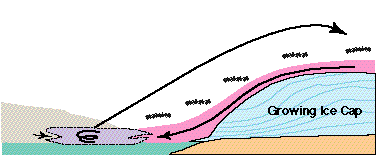
At that point in his story, the storyteller said, approvingly......
"Yes, we can get runaway storms, and you, my brainy friend, have just discovered a mystery. This is the way storms acted during the last great Ice Age, although we are not sure why."
"Now that we know how to get bigger storms," said our small
observer. "I guess they just keep bigger and dumping more snow until
there is an ice cap."
"you could say that", said the storyteller, "and you would be partly right. But it takes more to make an ice cap."
One more of nature's laws is needed before we can get our ice cap. Let's
call it the law of the warm radiator. The closer you get to a radiator,
the warmer it feels. Stand far away and freeze. Or move up close and stay
warm. In our story of the ice cap, the earth is the warm radiator.
Air is warmer at the earth's surface and the farther away you go, and the
higher up you go, the colder the air gets. The radiator law solves the problem
of the ice cap.

Why? Because every time a storm drops a new layer of snow, the snow turns
to ice, and the land grows higher. When the land grows higher the air grows
colder, the winds coming off the ice get colder and stronger, and the storms
get bigger.
"Then it is still feedback," said the listener. "So after
Antarctica moved to the South Pole I guess you could say that a growing
ice cap kept the ice cap growing."
"Yes, yes," said the storyteller, "once the feedback loop got started on Antarctica, there was no stopping it. The ice layers grew and the ice got higher, and higher, until the ice cap was two miles thick, until it was taller than a mountain, until it covered the entire continent, until there was no place left, until it started to ooze."
Previous Page.......................Next Page